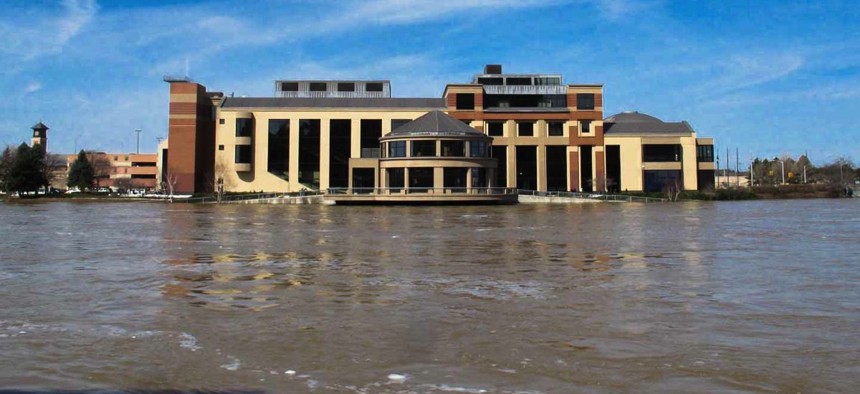Route Fifty City-County Roadtrip Recap: Grand Rapids Learns to Live With Its River Risks

The Grand Rapids Public Museum sits just above the Grand River during floods in April 2013. Steven Depolo / Flickr via CC BY 2.0
Instead of building up its floodwalls, Michigan’s second-largest city looks to try something different.
Route Fifty is currently featuring dispatches from a city-county summer roadtrip in Maryland, West Virginia, Pennsylvania, Ohio, Michigan and elsewhere along the way. An Introduction to the Series | Previous Stop: Wooster, Ohio | Next Stop: Saugatuck, Michigan
GRAND RAPIDS, Mich. — When you think about cities with vulnerable futures because of climate change and natural hazards, places like New Orleans and Norfolk come to mind because of their too-close-for-comfort proximities to rising seas. So too does Seattle , which is also waiting for an inevitable future megaquake that will bring great disruption and destruction across the Pacific Northwest.
Those are some of the places we’ve been examining this week at Route Fifty , as we mark the 10th anniversary of Hurricane Katrina’s twin natural and manmade disasters that unfolded in New Orleans and the Gulf Coast a decade ago.
Michigan’s second-largest city, about 30 miles inland from Lake Michigan, is comparatively a tranquil place (with a revitalized downtown, cool neighborhoods and very good beer ).
Grand Rapids is seismically stable and it's far above sea level. Like elsewhere in the Midwest, tornadoes can be a risk and some major thunderstorms can pack a punch, as can the lake-effect snow in the fall and winter.
In terms of debilitating disaster risk, Grand Rapids doesn’t exactly stack up to so many other at-risk cities around the nation. (I grew up in Grand Rapids and, aside from severe thunderstorms and bitter winter weather, I can't really remember a time when Grand Rapids was brought to its knees because of a natural disaster.)
But the area is by no means immune to disasters and the localized long-term impacts of climate change. More powerful storms are likely to dump higher amounts of precipitation on Michigan going forward, especially in the winters and springs, according to projections from the Union of Concerned Scientists and a 2013 resiliency report prepared by the West Michigan Environmental Action Council for the Grand Rapids City Commission.

And the Grand River, the longest in the state, has to drain the added rain and snowmelt. As the river passes through downtown Grand Rapids, it does so within the confines of large floodwalls. The grand rapids that once defined this stretch of the Grand River don't really exist in the same way they once did. The Sixth Street dam, which includes a fish ladder, reinforces that notion the Grand River has been tamed and isn’t quite wild.
Local officials and environmental advocates have been pushing a plan called Grand Rapids WhiteWater that would remove the dam and restore the river’s rapids.
While there are certainly environmental and economic benefits—Grand Rapids WhiteWater projects that expanded recreational use of the Grand River and the city’s riverfront will spur on $15.9 million to $19.1 million annually in net new economic impact—there are also important floodwater management benefits, too.
Like other local governments following Hurricane Katrina, Grand Rapids wasn’t exactly in the mood to raise its floodwalls when the Federal Emergency Management Agency was calling on cities to strengthen flood defenses.

But the Grand Rapids WhiteWater project will allow Grand Rapids to enhance its river recreation assets while also better accommodating the Grand River’s floodwaters , as The Grand Rapids Press reported last December:
“They’re not floodwalls. They’re a flood protection system,” said Jim Smalligan, a Fishbeck, Thompson, Carr & Huber engineer working with Grand Rapids. “Ten years ago we weren’t thinking about (Grand Rapids) Whitewater. We weren’t thinking about GR Forward (the new downtown planning process). So we were thinking about flood protection somewhat in a vacuum.
“Now we have an opportunity to do it right.”
That will mean instead of a solid concrete floodwall, there will be points along the river where there will be softer, more natural flood infrastructure, like a stepped-up embankment where the river could rise and fill other water-retention areas created when the river’s banks are reshaped as part of the efforts to restore the rapids.
In April 2013, Grand Rapids was reminded of the risks posed by the river. Floodwaters had pushed the Grand River to a nearly record-setting crest, sending 37,000 cubic feet of water per second through the river downtown, according to The Grand Rapids Press .
National media had picked up photos of the floodwaters from a unique vantage point—from inside an office building where floodwaters were gradually rising on the other side of the window pane . (Fish and ducks could be seen hanging out on the wet side of the glass.)
That year, Grand Rapids came within a few inches of a far more disruptive disaster, one that could have taken out the city’s water treatment plant and areas beyond its current flood protections. In 1904 , much of the city’s West Side flooded as the Grand River spilled out of its banks and floodwalls.
The rapids-restoration project and the enhanced flood protections would, in theory, help give the river more places to go during times of high flood waters.
This is a story we’re seeing play out in more places. Instead of investing only in hard infrastructure, cities can learn to better live with the risks posed by water. And in the case of Grand Rapids, with that risk also comes great economic-development opportunities.
In a Detroit Public Television program last year, Mayor George Heartwell, who has served on a White House on climate preparedness and resilience, discussed Grand Rapids’ “blue” economy and touted how the river is central to the city’s ongoing revitalization efforts: “The Grand River has been not only a target of our work but an inspiration and a motivator for us,” Heartwell said.
Next Stop : Saugatuck, Michigan
Michael Grass is Executive Editor of Government Executive's Route Fifty.
NEXT STORY: Ending Unlimited Solitary Confinement in California; Booker to the Rescue for New Jersey’s Tunnel Mess?






